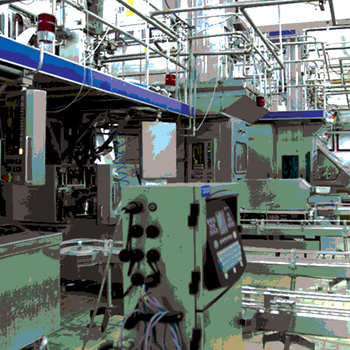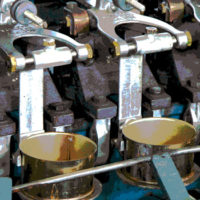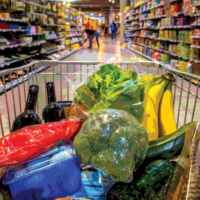The quality revolution, sparked by Toyota and its ability to produce more reliable cars, has now turned its face to the food industry. Think about it—30 years ago, a story about melamine-contaminated infant formula supplies in China would never have made news in this country. But consumers now know that the same deadly additives in Chinese milk can appear in toothpaste or cough syrup in Guatemala and Georgia. We know which California farm produced Escherichia coli-laced spinach, and we hear intimate details of a peanut processor’s factory floor.
Suddenly, the media and consumers are paying very close attention to food and its origins. Want to start a conversation these days? Open a jar of peanut butter.
With today’s heightened awareness, food processors should ask, “Are we ready for this kind of scrutiny?”
I visit a lot of food manufacturing sites every year and currently, I’d say the answer to the above question is likely “no.” And it’s not just because the cleaning crew is typically made up of the newest, least-trained and lowest-paid employees—clearly showing a plant’s priorities.
While food industry executives are trying to do the best they can, their concerns about low yields in tight markets has made it difficult to focus adequately on cleanliness and safety. The most effective way to improve quality, yield and the bottom line is by using the principles of Lean or LeanSigma.

Recently, I was invited to tour a plant that processes dairy products. While it seemed clean and well-organized, a closer look revealed a big issue that many food manufacturers need to face: lack of ownership and clear expectations around food safety.
Three key issues surfaced indicating that our dairy client could benefit from a Lean business system: 1) poor process yield (lots of expensive ingredients were being wasted when they landed on the floor); 2) ineffective capacity utilization (the machinery couldn’t make enough product to meet customer demand); and 3) unacceptable equipment reliability (long set-up times, cumbersome changeovers, and constant machine adjustment).
On this particular line, cottage cheese was being dispensed into plastic containers, weighed, and then visually inspected by a worker about 3 feet down the conveyor belt before the containers were sealed. Several minutes into the process, the dispensing machine started to malfunction, sending globs of cottage cheese onto the floor and walls.
The workers nearby merely glanced at the flying curds of cheese and went back to work. Nobody intervened until the plant’s owner appeared. The employees had no ownership of the process and saw no reason to stop the machine or clean up the mess. In their minds, unfortunately, they were being paid to inspect and apply lids—not to produce high-quality, safe food. They weren’t lazy; it was a problem of perception.
That’s why, when we talk about the fundamentals of Lean manufacturing, first on the agenda is the visual workplace, kaizen, and yield—because we need to see the process, own the process, and know that what we’re putting in is also coming out. All three are inextricably linked to the current demand for safe food.
While kaizen came out of the quality revolution within Toyota’s pioneering work, not everyone understands it well. Kaizen involves small, cross-functional teams of employees, and perhaps an outsider or two, who are empowered to tackle a problem and make improvements in the business, usually in 1 week. The team receives several hours of training in the principles of Lean manufacturing, and then turns its full attention to solving a problem and fixing it—immediately.
The real result of using kaizen teams—even more important than discovering why the cottage cheese dispenser is spraying small curds on the wall—is that operators, engineers, and supervisors all begin to own the process. They look for ways to improve. It becomes a way of life.
Those employees who let the cottage cheese fly weren’t bad people. They had gotten used to seeing stuff fall on the floor. They knew it was the job of a cleaning crew to pick it up eventually.
In a truly Lean factory, every employee sees “food on the floor” as an abnormality that must be addressed. A spotless environment should be the norm. It’s what the consumer expects. And they are starting to look carefully, which is another reason to use Lean principles and kaizen teams, to improve yield—an immediate driver of bottom-line improvement. Lean companies often utilize the DMAIC (Define, Measure, Analyze, Improve, and Control) process to make significant improvements in raw material utilization. Often, food and beverage manufacturers collect and archive mountains of process data but do not analyze them or use them to improve their processes. By effectively applying the DMAIC process and Six Sigma tools, significant financial benefits—often 1–2 percent of annual sales—can be realized through improvements in yield.
Not long ago, I was asked to perform a statistical analysis of the yield loss in a prepared foods factory where input of the most expensive ingredient was 100 pounds and output was 86 pounds. After each tray was finished, it was weighed. Those that didn’t meet the weight requirements got kicked to the side. When a few trays in a row got kicked aside, a worker walked over and turned the dial to dispense more of one type of food item onto the tray in order to meet the weight requirement.
The problem was that the worker had increased the most expensive ingredient of the package—throwing yield assumptions and balance sheets into disarray—without alerting anyone or investigating the issue. The best way to drive change is to invite people into the process by giving them a voice and encouraging them to participate and solve problems. Give people an incentive to take personal accountability. In a non-Lean environment, a worker might see a problem but think, “Hey, it’s not my job to identify or fix the problem—I just make the stuff.” In a Lean environment, the associate is empowered to stop the line and fix the problem. We generally start this process by establishing what we call “the visual factory.”
Most every food processor I visit has unexplained yield loss and most don’t have a visual factory. This is not a coincidence. In a visual factory, the workers have clear, easily understood visual cues to help them do their jobs. First steps in creating a visual factory include 5S, or workplace organization and standardization; real-time visual displays on the process and goals; and visual control to communicate information that supports standardized activities.
In this case, nobody ever set a clear, visual indicator as to what each ingredient should weigh. The worker was simply following the protocol he knew. Once procedures regarding control of critical variables are clearly defined, operators are encouraged to make consistent adjustments so that variation in the process is reduced, thereby increasing the utilization of raw material and equipment output. One of the most important tools in sustaining change is a visual management system that displays metrics and daily corrective actions. Management must create an environment where operators take charge of and responsibility for maintaining these metrics, analyzing the data, and reacting to them on a real-time basis.
Setting clear expectations and giving employees the power to correct abnormalities is the least expensive way to manufacture safe food. The addition of kaizen teams may, in the long run, be the secret sauce!
Read the sidebar: Getting Started
David Beal is a director and team leader of TBM Consulting Group and a LeanSigma® Master Black Belt; he had 25 years of experience in the automotive industry before turning his efforts to Lean conversions worldwide. Prior to joining TBM, Beal was the managing director of European operations for Preferred Technologies Group and a multi-site plant manager for United Technologies in the U.S. He has been a trusted advisor to companies, such as McCain Foods, Hubbell, Inc., and Pella Corporation.
Sidebar
Getting Started
The best solution to any problem is best derived from understanding the root cause. There’s nothing worse than spending a lot of time developing a solution only to learn that you fixed the wrong thing. In Lean we have a term, go to Gemba. Literally translated, it means go to the source. Don’t assign it to someone else. Go see for yourself.
If you’re looking for a place to start, go to Gemba and find at least one occurrence of each of the seven wastes. Each waste consumes costly resources that can affect safety, cash flow and profitability.
The seven wastes of any process include the following:
• Defective parts: These consume resources and increase the cost of finished goods. They are wasteful because they consume time and material used to produce something you can neither use nor sell. Not only have you wasted time and materials, but you must now inspect, rework, repair, and rebuild. Defects result in scrap, rework, and returns.
• Inventory: Once we overproduce, inventory must be stored in the warehouse, retrieved for shipping, people must move it, and computers must count it. This consumes valuable cash that could be otherwise deployed for more productive means.
• Motion: Excess motion is a wasteful activity—consuming time and resources that are not value added and/or causing harm to an operator due to poor ergonomic conditions.
• Overprocessing: This occurs when you make a product or service better than the customer wants it or is willing to pay for it. This type of waste may mean that you are giving away valuable products and/or consuming time and energy that could be spent on other products required to meet customer demand.
• Transportation: This involves excessively moving the product or material through the workplace—risking damage or delays and utilizing non-value-added resources to move items from one location to the next.
• Waiting: This involves any delay between one activity and the next. Machines, materials, and people end up waiting, thus causing excess labor costs or delays in meeting customer demand requirements.
While the improvement priorities are specific to each site, the places to go hunting for waste are very consistent. When food safety is involved, the best plan of attack is to start with the manufacturing activities that are most likely to affect the end-user. You can start by observing the sanitation cycle. While it may be difficult to see defects in the sanitation process, keep in mind that defects in quality or safety can be your most egregious waste. Why? Because quality and safety defects can affect your customers—either retailers who sell your product or the consumers who eat or drink what you manufacture.
Focus on areas that are difficult to clean and therefore less likely to be thoroughly clean. One example is a food manufacturer who detected an odor in its finished products. While the odor had no impact on the quality of the food for consumption, it was unpleasant and therefore unacceptable to the customer. It was imperative for the kaizen team to quickly identify the root cause, eliminate the problem, and sustain the results. Repetitive sanitization of the food processing equipment was not the solution. By digging deeper, the team identified equipment design as the root cause. Instead of rounded corners that are easy to wash and sanitize, the metal equipment had squared corners that twisted and turned—making it virtually impossible to thoroughly sanitize the deep crevices inside the processing equipment. A quick modification corrected the problem and allowed the team to get back on track. Standard work was established for equipment design and sanitization, and the problem was permanently eradicated.
These key steps are part of a process we call PDCA or Plan, Do, Check, and Act. It is a simple process that is effective in creating sustainable change. Create a plan of attack, execute the plan, check your results, and take action. This cycle never ends. Lean companies that effectively deploy the PDCA approach are among the best at solving problems and sustaining results. If you’re a food manufacturer, that means you’ll proactively identify issues, fix them, and keep them from happening again and again—ultimately improving quality and safety.




